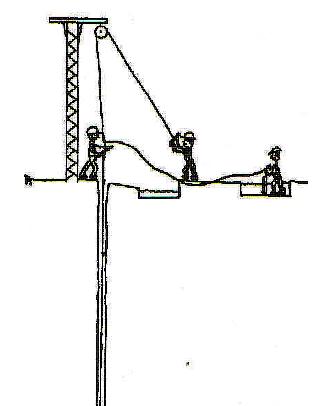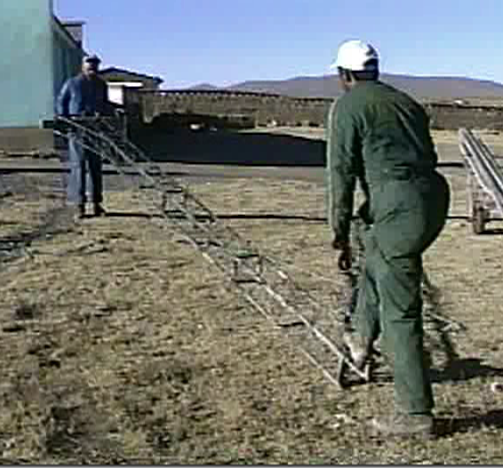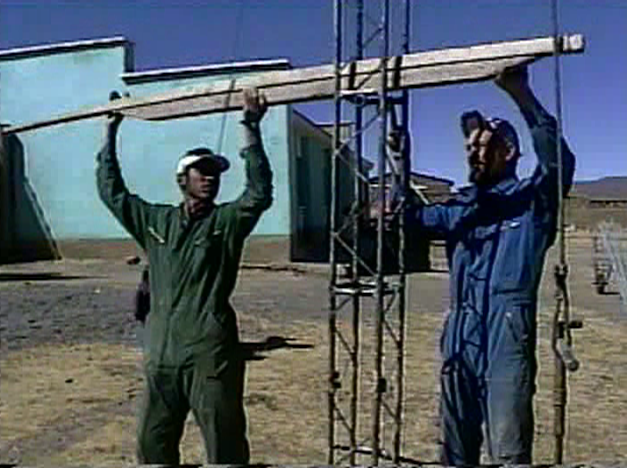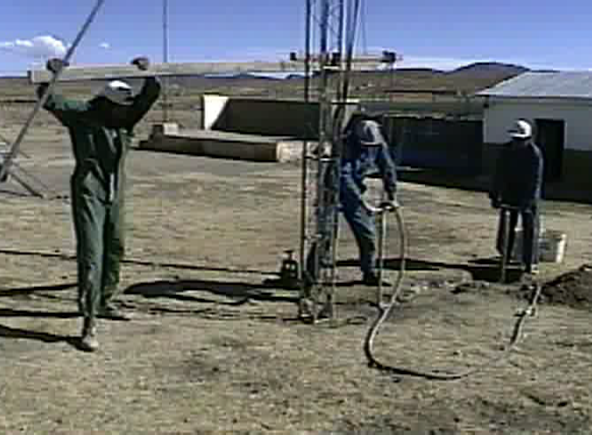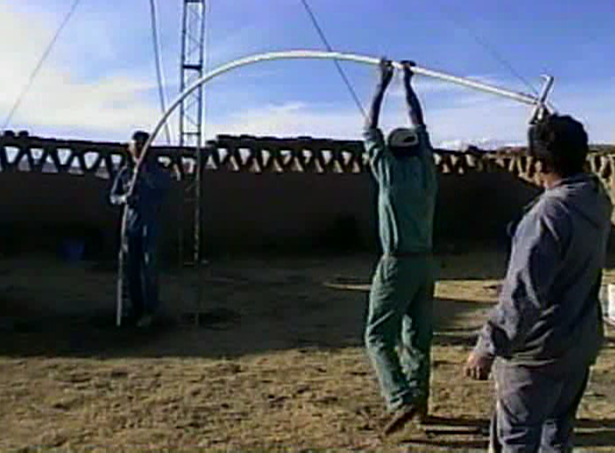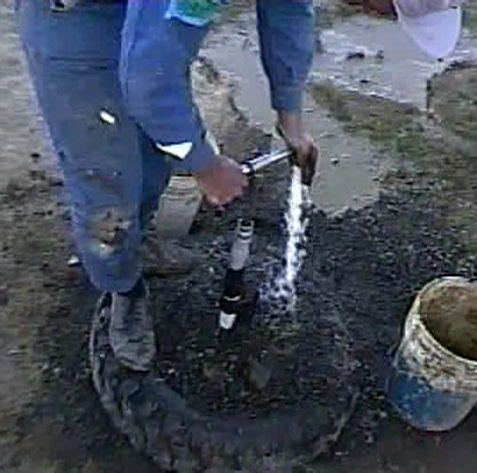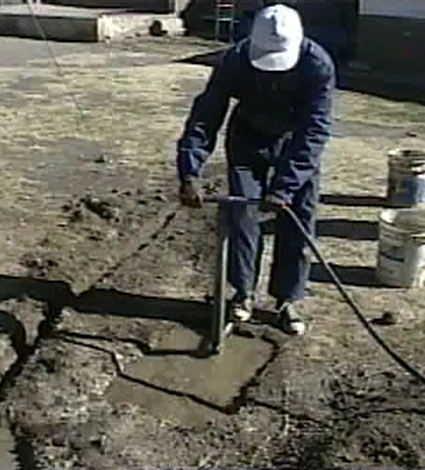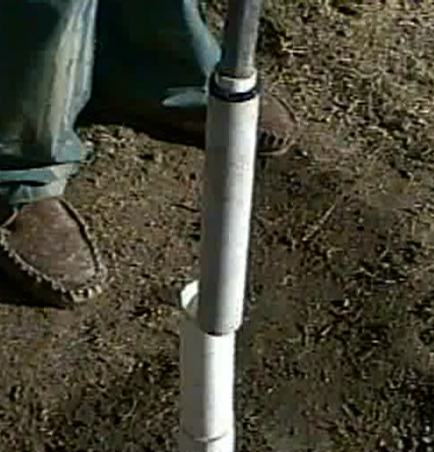Difference between revisions of "水力噴射-EMAS方法"
| (8 intermediate revisions by 2 users not shown) | |||
| Line 1: | Line 1: | ||
| + | {{Language-box|english_link= Jetting - EMAS method | french_link= Coming soon | spanish_link= Coming soon | hindi_link= Coming soon | malayalam_link= Coming soon | tamil_link= Coming soon | swahili_link=coming soon | korean_link= Coming soon | chinese_link=水力噴射-EMAS方法 | indonesian_link= Coming soon | japanese_link= Coming soon }} | ||
| + | |||
[[Image:Icon_EMAS_drilling.png|right|80px]] | [[Image:Icon_EMAS_drilling.png|right|80px]] | ||
| − | [[Image:Emas.jpg|thumb|right|200px| | + | [[Image:Emas.jpg|thumb|right|200px|在哥倫比亞以EMAS方法鑽井。]] |
| − | [[Image:Emas1.png|thumb|right|200px| | + | [[Image:Emas1.png|thumb|right|200px|所有的工具可輕易裝進一台小型手推車內。]] |
| − | + | ||
手工鑽井中的EMAS方法是融合了[[Jetting - general|水力噴射]]、[[Percussion - general|衝擊鑽法]]以及[[Sludging - Rota sludge|迴旋式]]之鑽井技術。此方法需使用手動泥泵,每個行程末端鑽桿皆轉90度;這可鑽鑿到各種鬆土、綜合材料及輕石。但鑽桿無法穿過硬原岩及卵礫石(如:地下的古老河床)。管井直徑一般為37毫米。 | 手工鑽井中的EMAS方法是融合了[[Jetting - general|水力噴射]]、[[Percussion - general|衝擊鑽法]]以及[[Sludging - Rota sludge|迴旋式]]之鑽井技術。此方法需使用手動泥泵,每個行程末端鑽桿皆轉90度;這可鑽鑿到各種鬆土、綜合材料及輕石。但鑽桿無法穿過硬原岩及卵礫石(如:地下的古老河床)。管井直徑一般為37毫米。 | ||
| Line 13: | Line 15: | ||
EMAS不只是水與衛生流動學校的名字,也是整個技術及社會對水和衛生的概念;包含收集雨水、太陽能熱水器、風力發電、液壓頂桿、水處理、小型貯水池與水槽、各式各樣的手泵與腳泵,及鋼筋混凝土貯水池。 | EMAS不只是水與衛生流動學校的名字,也是整個技術及社會對水和衛生的概念;包含收集雨水、太陽能熱水器、風力發電、液壓頂桿、水處理、小型貯水池與水槽、各式各樣的手泵與腳泵,及鋼筋混凝土貯水池。 | ||
| − | === | + | ===適宜條件=== |
| − | [[Image:Emas0.jpg|thumb|right|200px| | + | [[Image:Emas0.jpg|thumb|right|200px|EMAS鑽井]] |
| − | + | 僅以人力鑽鑿,不需使用機器可在三至四日內挖掘90公尺深的井。使用EMAS方法則可挖至100公尺。南美大部份的地區(砂壤土)在地質上適合此種EMAS鑽井方法(以沖洗式及吸式鑽井為主)。 | |
| − | + | 此技術適用於凝聚性弱之沙及淤泥;最適用於壤土、綜合材料及輕石。地質為純粗砂的情況下如果只使用沖洗式鑽井,進度會有些緩慢:因為就較狹窄的鑽桿而言,鑽桿及井壁間的空隙相對之下較大而造成水流緩慢向上流,導致鑽井泥漿中的沙下沉速度比上升的快。在此情況下能簡單的以改變把手來將沖洗式改變至吸式鑽井。例子提供於影片內。也有特別設計的萬能鑽頭對吸式及沖洗式皆十分好用,且不會被石頭堵塞。 | |
| − | + | 因為鑽孔會因水壓維持敞開狀態,為防止崩塌,整個鑽井及安裝過程中流體鑽孔需保持滿水狀態。一個20公尺的井,一、二桶水即足夠;或每公尺約10-20公升水。 | |
{| border="1" cellpadding="5" cellspacing="0" align="center" | {| border="1" cellpadding="5" cellspacing="0" align="center" | ||
|- | |- | ||
| − | ! width="50%" style="background:#efefef;" | | + | ! width="50%" style="background:#efefef;" | 優點 |
| − | ! style="background:#f0f8ff;" | | + | ! style="background:#f0f8ff;" | 缺點 |
|- | |- | ||
| − | | valign="top" | - | + | | valign="top" | - 在細微至中等沙質中使用起來極快。<br> |
| − | - | + | - 操作儀器簡單便宜。 <br> |
| − | - | + | - 無需使用機器。 <br> |
| − | - | + | - 無需使用電動泥泵及鑽塔。<br> |
| − | - | + | - 可在地下水位下作業。<br> |
| − | - | + | - 使用防腐、易取得及易處理之材料(聚乙烯與聚氯乙烯)。 <br> |
| − | - | + | - 維護成本低 <br> |
| − | - | + | - 低成本(含手泵每公尺約六美元)。此方法比起市面上最低成本的方法要經濟約十倍。<br> |
| − | - | + | - 適用於有著類似土質的其他國家及區域。<br> |
| − | | valign="top" | - | + | | valign="top" | - 一般受限於砂質土壤及軟黏土。 |
| − | - | + | - 在鑽井工址需有足夠的水可供使用。 <br> |
| − | - | + | - 鑽孔徹夜敞開有崩塌危險。<br> |
| − | - | + | - 工程比電動鑽井耗時。<br> |
|} | |} | ||
| − | === | + | ===建造工程、營運及維護=== |
| − | + | 軟黏土最易鑽鑿,在適宜條件之下,以此土質一天內可鑽鑿40公尺。包含清洗的水,每鑽鑿一公尺需10至20公升的水。一個20公尺的井只需一、二桶水即足夠。 | |
| − | + | 鑽井是一項不間斷的作業:在鑽鑿工作完成或被中斷之前,鑽頭通常不能從鑽孔上移除。按照插入鑽桿的比例,固定另一個長3/4吋(19毫米)、有著強化螺紋之金屬管。以手動泥泵將鑽井泥漿(普通黏土的懸浮物或密度適中的皂土所成的泥)經由鑽桿抽空。鑽井泥漿回升時會帶著碎裂的材料。沙及小石頭會沈澱於地上挖的沈澱區域,泥土則會經由泵再循環利用。 | |
| − | + | 衝擊式作業為:以槓桿將鑽頭抬起,安裝在鑽塔上再使其落下。接下來,鑽頭的兩頭各旋轉半圈,加強其研磨作用。 | |
| − | + | 鑽鑿而成的洞直徑約為兩呎,便宜的1又1/2吋(39毫米)聚氯乙烯管則作為井的套管。這能容納1又1/4吋的聚氯乙烯活塞泵。但如有需要,井的上半部(比最低預期水位低一公尺) 可擴大至能容納直徑稍大的泵。 | |
| − | + | 因為整個鑽桿為金屬製,鑽頭的重量會隨著深度線性增加。因此井越深,行程越重 (行程長度被槓桿限制為30公分)。 | |
| − | + | 不需使用臨時套管。越接近理想的深度,以逐漸注射低密度的泥土將鑽井泥漿從洞內移除。但如出現不穩定的分層,此稀釋行為可能造成井在裝套前崩塌。在此情況下,最好在井內先以泥裝套然後澆入或注入水進套管內排空泥土(反洗)。 | |
| − | + | 完整的設備可於當地的任何弧焊工廠建造,材料在一般五金行即可購買。 | |
{|style="border-style: solid; border-width: 1px 1px 1px 1px; text-align: center; background-color: #efefef" align="center" width="70%" | {|style="border-style: solid; border-width: 1px 1px 1px 1px; text-align: center; background-color: #efefef" align="center" width="70%" | ||
|- | |- | ||
| − | ! scope="col" |[[Image:Emas2.png|thumb|center|200px| | + | ! scope="col" |[[Image:Emas2.png|thumb|center|200px|設立輕量級鑽塔。]] |
| − | ! scope="col" |[[Image:Emas4.png|thumb|center|200px| | + | ! scope="col" |[[Image:Emas4.png|thumb|center|200px|安裝用來控制鑽桿上下移動的操作桿。]] |
| − | ! scope="col" |[[Image:Emas3.png|thumb|center|200px| | + | ! scope="col" |[[Image:Emas3.png|thumb|center|200px|鑽井過程中:一人執行操作桿,另一人操縱及旋轉鑽桿,第三人則操縱泥泵。]] |
| − | ! scope="col" |[[Image:Emas8.png|thumb|center|200px| | + | ! scope="col" |[[Image:Emas8.png|thumb|center|200px|置入EMAS的彈性泵。]] |
|- | |- | ||
| − | |[[Image:Emas7.png|thumb|center|200px| | + | |[[Image:Emas7.png|thumb|center|200px|打濕泵基部之水泥。]] |
| − | |[[Image:Emas5.png|thumb|center|200px| | + | |[[Image:Emas5.png|thumb|center|200px|封起泥泵。]] |
| − | |[[Image:Emas6.png|thumb|center|200px| | + | |[[Image:Emas6.png|thumb|center|200px|井的濾管以鋸子切出縫隙,尾端加蓋。之後,將一隻襪子纏繞於濾管上。]] |
| − | |[[Image:Emas9.png|thumb|center|200px| | + | |[[Image:Emas9.png|thumb|center|200px|井裝上濾管後接著使用特殊工具開發。]] |
|} | |} | ||
| − | === | + | ===花費=== |
| − | + | 適用於最深30公尺之EMAS鑽井設備,在玻利維亞造價約為600至800美元。此花費也包含鑽塔、泥泵及所有用於營運及維護鑽井的罕見工具。 | |
| − | + | 多數情況下,管井結合了[[EMAS pump|EMAS手泵]]。在玻利維亞,每公尺的總成本在4至10美元之間,包含勞力、材料、手泵,以及一年保固。而標準價格則為每公尺5至6美元。 | |
| − | + | 此價格以三部分來計算。以6美元為基準,2美元為材料及手泵費(如果井深為20公尺則包含水泵),2美元為兩名鑽井工人之薪資(包含維護器具費用),2美元作為儲備基金以應對沒水、只有鹹水、或是鑽井錯誤以致鑽桿壞損或裝錯過濾套等情況。一般而言,5美元的價格會附加一年保固,以防使用四個星期後有留下沙子的情況。 | |
| − | |||
| − | |||
| − | + | 玻利維亞的井深平均約27公尺,含[[EMAS pump|EMAS手泵]]成本約180美元。此價格使得農村能加建井的蓋子,市鎮政府及家庭們因而能有飲用水。 | |
| − | === | + | ===實地經驗=== |
| − | + | EMAS方法多使用於玻利維亞、巴拿馬、厄瓜多爾、巴拉圭、巴西、秘魯、宏都拉斯、尼加拉瓜、薩爾瓦多、瓜地馬拉、厄立特里亞及斯里蘭卡。 | |
| − | === | + | ===指南、影片及連結=== |
| − | + | EMAS製作了一套DVD,內容包含EMAS鑽井及其他低成本的供水技術。如需訂購此DVD,請來信至emas@entelnet.bo或emas@ceibo.entelnet.bo聯絡位於玻利維亞的沃夫岡・布赫納。 | |
| − | + | EMAS手工鑽井是以手鑽鑿小孔徑管井的方法,融合了沖激鑽探、衝擊鑽法以及迴旋鑽井技術。這使各種鬆土、綜合材料及輕石皆可被鑽鑿到。但鑽槓無法穿過硬原岩及卵礫石(如:地下的古老河床)。管井直徑一般為37毫米。影片由沃夫岡・布赫納製作。 | |
| − | * | + | * 不同主題的[https://vimeo.com/emas EMAS影片集]。 |
{|style="font-size: 120%" | {|style="font-size: 120%" | ||
|- | |- | ||
| − | |{{#ev:youtube|B9zXHIrsdiw|200|auto|<center> | + | |{{#ev:youtube|B9zXHIrsdiw|200|auto|<center>鑽井-EMAS標準方法<br>第一部份 |
| − | |{{#ev:youtube|T8SivxJ8LWg|200|auto|<center> | + | </center>}} |
| − | |{{#ev:youtube|mPz4WxQ245c|200|auto|<center> | + | |{{#ev:youtube|T8SivxJ8LWg|200|auto|<center>鑽井-EMAS標準方法 <br>第二部份</center>}} |
| + | |{{#ev:youtube|mPz4WxQ245c|200|auto|<center>吸式鑽井的變化到<br>EMAS標準方法第一部份</center>}} | ||
|- | |- | ||
| − | |{{#ev:youtube|qHwReBdKkr8|200|auto|<center> | + | |{{#ev:youtube|qHwReBdKkr8|200|auto|<center>鑽井-軟泥法與臨時套管 <br>第一部份</center>}} |
| − | |{{#ev:youtube|EIjSb7-z5fU|200|auto|<center> | + | |{{#ev:youtube|EIjSb7-z5fU|200|auto|<center>鑽井- 軟泥法與臨時套管<br>第二部份</center>}} |
| − | |{{#ev:youtube|EmB9EFFNKc0|200|auto|<center> | + | |{{#ev:youtube|EmB9EFFNKc0|200|auto|<center>鑽井- 軟泥法與臨時套管 <br>第三部分</center>}} |
|} | |} | ||
| − | ==== | + | ====其他資料來源==== |
| − | * | + | * 技術示範中心-EMAS水力噴射作業。請見[[Technology Demonstration Centers|技術示範中心]] |
| − | * [http://www.emas-international.de/index.php?id=51&L=3 EMAS] | + | * [http://www.emas-international.de/index.php?id=51&L=3 EMAS]的鑽井技術。 |
| − | * [http://paulcloesen.50webs.com/In-EN.htm | + | * [http://paulcloesen.50webs.com/In-EN.htm Paul Cloesen的EMAS鑽井資料]。 |
| − | * | + | * 郊區供水網絡,[http://www.rural-water-supply.net/en/implementation/manual-drilling/emas-drilling EMAS鑽井文章]。 |
| − | *[[Solution_of_the_week_10|Akvo | + | *[[Solution_of_the_week_10|Akvo 解決方案第十週]] |
| − | *[[Solution_of_the_week_11|Akvo | + | *[[Solution_of_the_week_11|Akvo 解決方案第十一週]] |
| − | === | + | ===感謝=== |
| − | * | + | * 此文章根據[http://www.paulcloesen.50webs.com/ Paul Cloesen]的[http://www.paulcloesen.50webs.com/In-EN.htm 文章]及[http://www.emas-international.de/index.php?id=51&L=3 emas-international.de]提供的材料所撰寫。 |
Latest revision as of 23:29, 5 September 2016
| |
|
|
|
|
|
|
|
|
|
手工鑽井中的EMAS方法是融合了水力噴射、衝擊鑽法以及迴旋式之鑽井技術。此方法需使用手動泥泵,每個行程末端鑽桿皆轉90度;這可鑽鑿到各種鬆土、綜合材料及輕石。但鑽桿無法穿過硬原岩及卵礫石(如:地下的古老河床)。管井直徑一般為37毫米。
EMAS鑽井法是由玻利維亞的Escuela Móvil de Agua y Saneamiento(水與衛生流動學校)所開發。EMAS在玻利維亞的計畫領袖沃夫岡・埃里吉斯・布赫納,於1957年出生在慕尼黑的霍爾茨基興鎮。EMAS建立於1993年,已在聖胡利安(1994年)及裴瑞玆(1997年)的部門培訓了約130位獨立造井師,其中有20位學生從認證過的工藝課程中畢業。玻利維亞的造井師們創立了一個造井師組織。
EMAS建立於1993年,已在聖胡利安(1994年)及裴瑞玆(1997年)的部門培訓了約130位獨立造井師,其中有20位學生從認證過的工藝課程中畢業。玻利維亞的造井師們創立了一個造井師組織。
三個月的訓練過程中,農業工人受訓如何獨立鑽井、建造衛生設施、及在當地社區視需求推廣自己的技術。因鑽井及建造線路系統需要大量投資,所以一直以來難以實現在郊區建造大規模的飲水系統。沃夫岡・布赫納依照當地情況,改建了原本受到大眾接受的吸式及沖洗式鑽井系統。
EMAS不只是水與衛生流動學校的名字,也是整個技術及社會對水和衛生的概念;包含收集雨水、太陽能熱水器、風力發電、液壓頂桿、水處理、小型貯水池與水槽、各式各樣的手泵與腳泵,及鋼筋混凝土貯水池。
Contents
適宜條件
僅以人力鑽鑿,不需使用機器可在三至四日內挖掘90公尺深的井。使用EMAS方法則可挖至100公尺。南美大部份的地區(砂壤土)在地質上適合此種EMAS鑽井方法(以沖洗式及吸式鑽井為主)。
此技術適用於凝聚性弱之沙及淤泥;最適用於壤土、綜合材料及輕石。地質為純粗砂的情況下如果只使用沖洗式鑽井,進度會有些緩慢:因為就較狹窄的鑽桿而言,鑽桿及井壁間的空隙相對之下較大而造成水流緩慢向上流,導致鑽井泥漿中的沙下沉速度比上升的快。在此情況下能簡單的以改變把手來將沖洗式改變至吸式鑽井。例子提供於影片內。也有特別設計的萬能鑽頭對吸式及沖洗式皆十分好用,且不會被石頭堵塞。
因為鑽孔會因水壓維持敞開狀態,為防止崩塌,整個鑽井及安裝過程中流體鑽孔需保持滿水狀態。一個20公尺的井,一、二桶水即足夠;或每公尺約10-20公升水。
| 優點 | 缺點 |
|---|---|
| - 在細微至中等沙質中使用起來極快。 - 操作儀器簡單便宜。 |
- 一般受限於砂質土壤及軟黏土。
- 在鑽井工址需有足夠的水可供使用。 |
建造工程、營運及維護
軟黏土最易鑽鑿,在適宜條件之下,以此土質一天內可鑽鑿40公尺。包含清洗的水,每鑽鑿一公尺需10至20公升的水。一個20公尺的井只需一、二桶水即足夠。
鑽井是一項不間斷的作業:在鑽鑿工作完成或被中斷之前,鑽頭通常不能從鑽孔上移除。按照插入鑽桿的比例,固定另一個長3/4吋(19毫米)、有著強化螺紋之金屬管。以手動泥泵將鑽井泥漿(普通黏土的懸浮物或密度適中的皂土所成的泥)經由鑽桿抽空。鑽井泥漿回升時會帶著碎裂的材料。沙及小石頭會沈澱於地上挖的沈澱區域,泥土則會經由泵再循環利用。
衝擊式作業為:以槓桿將鑽頭抬起,安裝在鑽塔上再使其落下。接下來,鑽頭的兩頭各旋轉半圈,加強其研磨作用。
鑽鑿而成的洞直徑約為兩呎,便宜的1又1/2吋(39毫米)聚氯乙烯管則作為井的套管。這能容納1又1/4吋的聚氯乙烯活塞泵。但如有需要,井的上半部(比最低預期水位低一公尺) 可擴大至能容納直徑稍大的泵。
因為整個鑽桿為金屬製,鑽頭的重量會隨著深度線性增加。因此井越深,行程越重 (行程長度被槓桿限制為30公分)。
不需使用臨時套管。越接近理想的深度,以逐漸注射低密度的泥土將鑽井泥漿從洞內移除。但如出現不穩定的分層,此稀釋行為可能造成井在裝套前崩塌。在此情況下,最好在井內先以泥裝套然後澆入或注入水進套管內排空泥土(反洗)。
完整的設備可於當地的任何弧焊工廠建造,材料在一般五金行即可購買。
花費
適用於最深30公尺之EMAS鑽井設備,在玻利維亞造價約為600至800美元。此花費也包含鑽塔、泥泵及所有用於營運及維護鑽井的罕見工具。
多數情況下,管井結合了EMAS手泵。在玻利維亞,每公尺的總成本在4至10美元之間,包含勞力、材料、手泵,以及一年保固。而標準價格則為每公尺5至6美元。
此價格以三部分來計算。以6美元為基準,2美元為材料及手泵費(如果井深為20公尺則包含水泵),2美元為兩名鑽井工人之薪資(包含維護器具費用),2美元作為儲備基金以應對沒水、只有鹹水、或是鑽井錯誤以致鑽桿壞損或裝錯過濾套等情況。一般而言,5美元的價格會附加一年保固,以防使用四個星期後有留下沙子的情況。
玻利維亞的井深平均約27公尺,含EMAS手泵成本約180美元。此價格使得農村能加建井的蓋子,市鎮政府及家庭們因而能有飲用水。
實地經驗
EMAS方法多使用於玻利維亞、巴拿馬、厄瓜多爾、巴拉圭、巴西、秘魯、宏都拉斯、尼加拉瓜、薩爾瓦多、瓜地馬拉、厄立特里亞及斯里蘭卡。
指南、影片及連結
EMAS製作了一套DVD,內容包含EMAS鑽井及其他低成本的供水技術。如需訂購此DVD,請來信至[email protected]或[email protected]聯絡位於玻利維亞的沃夫岡・布赫納。
EMAS手工鑽井是以手鑽鑿小孔徑管井的方法,融合了沖激鑽探、衝擊鑽法以及迴旋鑽井技術。這使各種鬆土、綜合材料及輕石皆可被鑽鑿到。但鑽槓無法穿過硬原岩及卵礫石(如:地下的古老河床)。管井直徑一般為37毫米。影片由沃夫岡・布赫納製作。
- 不同主題的EMAS影片集。
第一部份 |
第二部份 |
EMAS標準方法第一部份 |
第一部份 |
第二部份 |
第三部分 |
其他資料來源
- 技術示範中心-EMAS水力噴射作業。請見技術示範中心
- EMAS的鑽井技術。
- Paul Cloesen的EMAS鑽井資料。
- 郊區供水網絡,EMAS鑽井文章。
- Akvo 解決方案第十週
- Akvo 解決方案第十一週
感謝
- 此文章根據Paul Cloesen的文章及emas-international.de提供的材料所撰寫。


